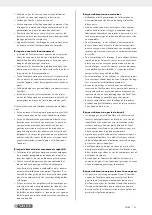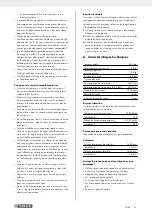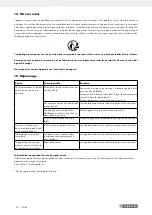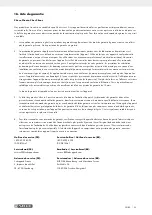
14
GB/IE
creased vibrations. Sharp tools should therefore always
be used.
• When hammering, never cool hot accessories in water.
This can lead to brittleness and premature failure.
• When hammering, misuse of the tool as a lever for ex-
ample for lifting, can result in the chisel breaking or dam-
age to the tool. Work on small sections at a time to avoid
becoming stuck.
• Avoid any direct contact with the mounted tool both dur-
ing and after use because it may be hot or have sharp
edges.
Risks in the workplace
• Slipping, tripping and falling are the main reasons for ac-
cidents in the workplace. Pay attention to surfaces that
may have become slippery as a result of using the air
tool, and also be careful that the air hose does not cause
someone to trip.
• Proceed carefully when working in unfamiliar environ-
ments. Power cables and other supply lines may repre-
sent a hidden risk.
• The air tool is not designed for use in explosive environ-
ments and is not insulated against contact with sources
of electric power.
• Ensure that no there are no electric cables or gas pipes
etc. where you are working and which can lead to a
hazard if damaged when you use the machine.
Risks associated with dust and vapours
• The dust and vapours generated when the air tool is
used may carry health risks (e.g. cancer, birth defects,
asthma and/or dermatitis); it is therefore imperative that
a risk assessment is carried out in relation to these risks
and that suitable controls are then implemented.
• The risk assessment should take into account both the
dust generated while the air tool is used and any existing
dust that may be raised during operation.
• The air tool must be operated in accordance with the
recommendations set forth in these instructions and must
be maintained in order to minimise the release of dust
and vapours.
• The extracted air must be discharged in such a way that,
in a dust-filled environment, the minimum of dust is raised.
• If dust or vapours are generated, the main priority is to
control these at the point where they are released.
• All integral or accessory parts on the air tool that are de-
signed to collect, extract or prevent airborne dust or va-
pours must be used and maintained in accordance with
the manufacturer‘s instructions.
• To avoid increasing the amount of dust or vapours gener-
ated unnecessarily, the consumables and the mounted
tool must be selected, maintained and replaced in ac-
cordance with these instructions.
• Use protective breathing apparatus in accordance with
your employer instructions or in accordance with health
and safety regulations.
Risks during operation
• When using the machine, the operator‘s hands may be
exposed to potential risk of impacts, cuts, abrasions and
heat. To protect your hands, wear suitable gloves.
• The operator and maintenance staff must be physically
capable of handling the size, weight and power output
of the machine.
• Make sure you hold the air tool correctly: be prepared
to counter both routine and unexpected movements, so
keep both hands ready.
• Make sure your body is in balance and that you have a
secure footing.
• Enable the command device to start or stop in the event
of a power failure. Avoid accidental operation.
Only use lubricants that have been recommended by the
manufacturer.
• Avoid any direct contact with the mounted tool both dur-
ing and after use because it may be hot or have sharp
edges.
• Wear personal protective equipment and always wear
safety glasses. By wearing personal protective equip-
ment such as gloves, protective clothing, a dust mask,
non-skid safety shoes, a safety helmet or ear protectors,
to suit the type of machine and its use, you reduce the
risk of injury. Wearing this equipment is recommended.
Risks associated with recurring movements
• When using a non-rotating beating machine, the opera-
tor may experience unpleasant sensations in the hands,
arms, shoulders, neck or other parts of the body when
performing work-related activities.
• Take a comfortable position when working with the
non-rotating, beating machine, pay attention to a se-
cure hold, and avoid unfavorable positions or positions
where it is difficult to maintain balance. If carrying out
work over an extended period, you/the operator should
change position occasionally. This should help to avoid
fatigue and any unpleasant sensation.
• If the operator experiences persistent symptoms such
as feeling unwell, aches, pains or throbbing, a prickling
or burning sensation, loss of hearing, or joint stiffening,
these warning signs must not be ignored. The operator
should advise the employer of these symptoms and con-
sult a qualified doctor.
Risks associated with accessory parts
• Disconnect the non-rotating, percussive machine from the
power supply before attaching or changing the machine
tool or accessory.
• Only use accessories and consumable of the sizes and
types recommended by the manufacturer of the non-
rotating percussive machine; use no other types or sizes
of accessories and consumables.
• Never use the chisels as a hammer or other hand tool.
They are specially designed for use in the non-rotating
percussive machine and have been heat-treated accord-
ingly.
• Never use blunt chisels as hammers or breakers as ex-
cessive pressures are needed for these application and
fatigue fractures can result. Blunt tools can lead to in-
Summary of Contents for PDUW 280 A1
Page 4: ...1 2 3 5 4 8 7 7A 7B 7D 7C 7E 9 10 11 1 2 3A 3B 3 13 12 6...
Page 5: ...3 4 3 4 5 6 8 9 10 11 7 1 1A 7E 7B 7C 7D 7A 5A 5A 3x...
Page 55: ...50...
Page 57: ......
Page 58: ...35 36 37 38 32 33 35 34 36 37 38 28 29 30 27 32 31 33 35 34...
Page 59: ......
















































